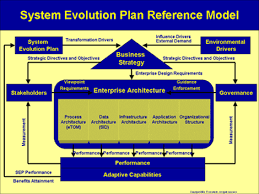IT Architects™ System Evolution Plan
An organization’s inter-related business, application and technology environment is a complex place. It is made up of intricate relationships and interdependencies between an enterprises process, data, infrastructure, application, and organizational architectures – typically captured by way of an Enterprise Architecture. The IT Architects™ System Evolution Plan framework is an enterprise-level plan used to guide the organizational planning of system evolution efforts. This framework must consider important corporate issues such as its business strategy, environmental drivers that influence corporate priorities, and performance feedback from the Enterprise Architecture early in the planning cycle to provide insight and guidance for a disciplined system evolution approach.
The System Evolution Plan Reference Model illustrated below is a high-level model depicting the important components driving the System Evolution Plan (SEP).
 Each component of the System Evolution Plan Reference Model is described below:
Each component of the System Evolution Plan Reference Model is described below:
Business Strategy: A business strategy is the business plan that sets out the corporate priorities and the allocation of resources to make it happen. Business strategic components include goals, priorities, problems, opportunities, rules and environmental influences. Strategic directives and objectives are the products of the Business Strategy. These are inputs to internal Stakeholders and the corporate governance. The business strategy also defines the enterprise design requirements that are used as primary drivers to configure the Enterprise Architecture.
Environmental Drivers: Influencers outside of the corporation that have a measurable influence and shape the business strategy. This includes competitive challengers, regulators, legislation, industry alignment, economic conditions and cultural considerations.
The Enterprise Architecture (EA): Enterprise Architecture (EA) is a complete expression of the enterprise; a master plan which “acts as a collaboration force” between aspects of business planning such as goals, visions, strategies and governance principles; aspects of business operations such as business processes, tasks, activities, information and organizational structures; aspects of automation such as information systems and databases; and the enabling technological infrastructure of the business such as computers, operating systems and networks. Performance metrics are derived from the EA and transferred to Stakeholder and Governance for evaluation.
Stakeholders: Parties with a vested interest in the success of the business strategy. Stakeholders provide viewpoints and requirements to the EA which in turn shape the configuration of the EA.
Governance: Internal regulators who provide guidance and enforcement of rules to ensure compliance with standards, policies and solution conformance testing.
Performance: Metrics reflecting the performance of each component of the EA and collectively the performance of the EA as a whole.
Adaptive Capabilities: SEP Performance and Benefits Attainment reflect how well the EA is performing in relation to expectations. Are investments in information technologies delivering the anticipated value and benefits that were originally envisioned or should adjustment be made?
System Evolution Plan: Identifies the transformation drivers and the EA components that require adjustment, enhancement or replacement in order to align with business directives and objectives.
The SEP Reference Model is used as a “road map” to assist the development of an overall understanding of an organization’s technology and application mix, environmental drivers, and its business strategy. It is also used as a navigation tool to guide the organization in focusing on specific areas needed for evaluation. For example, an organization may be inclined to gain an understanding of its current state of the Enterprise Architecture by developing a series of architectural models reflecting the physical architecture as well as how it supports key business processes. These models and related deliverables will establish the benchmark to compare future state SEP alternatives as well as identify gaps between the current and future states.
As an organization delivers all the various architectural models to support the System Evolution Plan, it must assign various individuals to develop these application and technical architectures. These individuals will be responsible for bringing these architectures together via the various models comprising the Enterprise Architecture.


